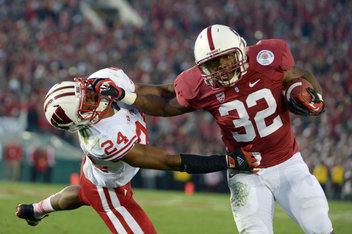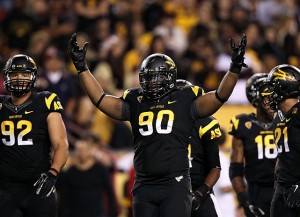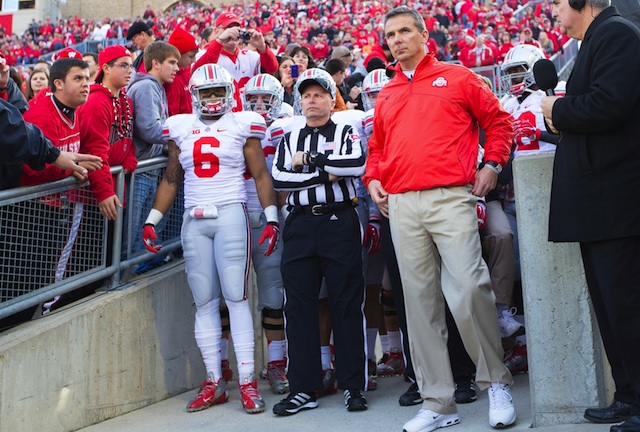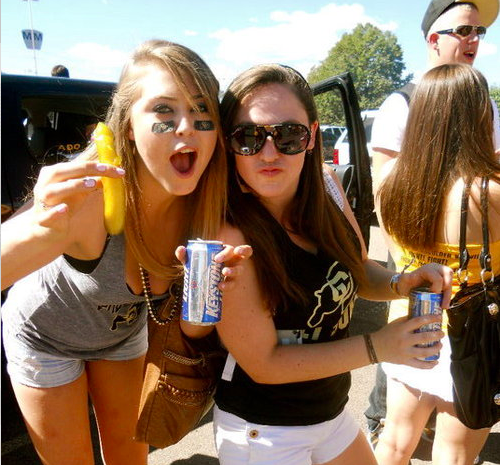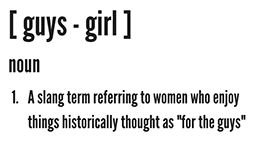Well ladies and gentlemen, it’s that time of year again. Football season is nearly upon us!
Gone are the summer doldrums without any pigskin action. Finally, we can actually watch teams play rather than hear about the latest scandal or Johnny Manziel’s lifestyle choices. Football is here, and it’s about time.
To get you up to speed after the summer hiatus, GuysGirl will be previewing all ten FBS conferences (RIP WAC, you’ll be missed) from east to west, starting with the Pac-12.
The Pac-12 is a league on the rise and the biggest threat to SEC supremacy. The league had two teams finish 2012 ranked in the top ten and begins 2013 with two teams in the top five.
Larry Scott has the league thinking big, Oregon is still loaded, and Stanford has proven it can be successful without Jim Harbaugh and Andrew Luck. Rich Rodriguez is making things exciting in Tucson, Todd Graham may actually have been a great higher in Tempe, Jim Mora Jr.’s Bruins were a pleasant surprise last year, and California hired the man who led the nation’s most prolific scoring offense a year ago.
Even lowly Colorado, 1-11 a year ago with a loss to FCS Sacramento State, has reason for optimism after hiring Mike MacIntyre, the man who turned around San Jose State and gave the Spartans their best season in decades.
Entering the 2012 season, the Pac-12 was expected to have a couple of national championship contenders. Oregon lived up to the billing and was a late-season loss away from playing for the national title. The surprise was USC. The Trojans began the year ranked #1 behind senior quarterback and Heisman favorite Matt Barkley, but USC stumbled. The Trojans finished the season unranked at 7-6, suffering a humiliating loss to Georgia Tech in the Sun Bowl.
Fortunately for the Pac-12, Stanford stepped up. Questions swirled around the Cardinal after Andrew Luck left for the NFL. Could the team sustain their success? Could David Shaw thrive without the talent stockpiled by Jim Harbaugh? Well, the answer is yes. Stanford went 12-2, gave Oregon its only loss and knocked the Ducks out of the national championship game, won the Pac-12 title, and appeared in a BCS bowl for the third straight year en route to a top-10 ranking.
Oregon State rebounded from some subpar years and went 9-4 to finish in the top 20, UCLA won the Pac-12 South in Jim Mora Jr.’s first year at the helm, and both Arizona and Arizona State provided gave their fans plenty of hope for the future with 8-5 campaigns under new coaches.
What will 2013 deliver?
Cream of the Crop
Oregon, Stanford
The Ducks and Cardinal and head-and-shoulders above the rest of the conference and the clear elite in the Pac-12. Not only are both vying for the Pac-12 crown, but both are ranked in the top five and national title contenders.
The Ducks have risen to prominence behind their flashy, bottomless sea of uniform combinations and a high-octane offense that leaves defenses and scoreboard operators gasping for breath.
The Ducks suffered a big loss in the offseason when Chip Kelly left to become the head coach of the Philadelphia Eagles. Offensive coordinator Mark Helfrich has been handed the reins, and he’ll have plenty to work with to keep the Ducks’ offense running smoothly.
Quarterback Marcus Mariota burst onto the scene a year ago as a red-shirt freshman, throwing for nearly 2,700 with 32 touchdowns and only 6 interceptions. Imagine how good he’ll be now that he has a year of experience under his belt.
He’ll be assisted by the dynamic De’Anthony Thomas as well as his top six receiving targets from a year ago and five returning offensive linemen with starting experience. Oregon’s defense is deep, talented, and anchored by one of the nation’s best secondaries. Led by cornerback Ifo Ekpre-Olomu, the nine returning secondary members combined for an eye-opening 18 interceptions, 268 tackles, 43 passes defensed, 7 forced fumbles (and 7 recoveries), and 8 tackles for loss.
The Ducks may suffer a drop off with the departure of Kelly, but it won’t happen this year. With the talent assembled by his predecessor, Helfrich may become the next Larry Coker and win a national championship in his first season.
For the Ducks to get that elusive crystal football, they’ll have to get through the immovable object known as the Stanford defense.
The Cardinal boast the best defense in the conference and one of the best in the nation. Only one starter from last year’s stout front seven departed, and that came at the deepest and most talented position in the defense: linebacker. Senior Trent Murphy had 18 tackles for loss and 10 sacks a year ago, and he’ll be joined by fellow seniors Shayne Skov, A.J. Tarpley, and Jarek Lancaster. Not to be outdone, the secondary features some outstanding players of its own. Safety Jordan Richards and cornerback Usua Amanam combined for 17 tackles for loss, 4 interceptions, 5 sacks, and 19 pass breakups.
The defense will have to live up to its building as the offense has some question marks. Quarterback Kevin Hogan took over the starting role in the 9th game of the year and never looked back. Hogan has yet to lose a game, but he’ll be without tight end Zach Ertz and running back Stepfan Taylor. Running back Tyler Gaffney returns to help ease the loss of Taylor, but the receivers and tights ends will have to step up and give Hogan some weapons.
Middle of the Pack
Oregon State, UCLA, Arizona, Arizona State, USC, Washington, Utah
“Middle of the Pack” isn’t really a fair way to describe the Pac-12 teams as there are a couple of tiers within this grouping. Oregon State had nine wins last year and nearly knocked off Stanford. UCLA also won nine games en route to the Pac-12 South title and nearly upset Stanford to claim a Rose Bowl berth and Pac-12 crown. Jim Mora Jr. has the Bruins on the rise. USC stumbled, but they’re still USC. The Trojans are loaded with talented players destined for a look in the NFL. Whether Lane Kiffin gets them to play up to their potential, however, is a question. Look for Oregon State to have a season similar to 2012: 8-10 wins but not able to beat Oregon and win the North. UCLA should be in the mix in the South division, and while USC has question marks–particularly at quarterback–and won’t contend for a national title, the Trojans will be better than last year’s dismal 7-6 performance.
While those teams aren’t on the same level as Oregon and Stanford, they are above the rest of the middle of the conference. Arizona and Arizona State have plenty to be excited about after identical 8-5 campaigns under new head coaches. The Wildcats lose senior quarterback Matt Scott but still have stud running back Ka’Deem Carey, who rushed for nearly 2,000 yards last season, as well a number of returning starters from an improved defense. Don’t be surprised if Arizona improves from a year ago but regresses in the standings. Still, things are looking up in Tucson.
Todd Graham’s first season in Tempe saw the Sun Devils nearly win the Pac-12 South as Arizona State featured a fast, fun team on both sides of the ball. The Devils have a brutal early schedule that could doom them (Wisconsin, at Stanford, USC, Notre Dame in four straight weeks), but if they can survive that, they should be in good shape. Pull off an upset or two, and things could get really interesting in Tempe. With nose tackle Will Sutton leading the defense and quarterback Taylor Kelly pulling the strings on offense, ASU will certainly be entertaining to watch.
The Washington Huskies are nothing if not consistent. Steve Sarkisian’s bunch has gone 7-6 the past three seasons. Quarterback Keith Price struggled with a new offensive system, but the defense improved considerably under new coordinator Justin Wilcox. There were some upsets, too; the Huskies defeated Oregon State and Stanford, both ranked in the top ten at the time. This team is incredibly young, but the Huskies are also full of talent. They are probably a year away from threatening the upper echelon, but if they catch a few breaks this year, they could definitely break through their recent 7-win ceiling. Six to eight wins is more likely, though.
Utah is in danger of dropping into the lower tier. The original BCS busters haven’t found the going as smoothly in the Pac-12 as they had hoped. Their inaugural season in 2011 was fine–the Utes were one loss from playing in the Pac-12 championship game–and came into 2012 with high hopes. A hyped defense failed to live up to expectations, and the offense was plagued by injuries and ineffectiveness. Utah went 5-7 and snapped a nine-season bowl streak. The vibe entering 2013 is certainly different than a year ago, especially since Utah’s strengths–defense and special teams–have been depleted. The hope now isn’t contending for a conference title, it’s merely to keep from losing ground. The Utes picked a bad time to stagnate and regress when so many other conference foes are on the upswing.
Bottom of the Barrel
Cal, Washington State, Colorado
Cal is on this list based on their recent performances, but don’t expect the Bears to stay here for long. Jeff Tedford had revived a downtrodden Cal program and made it relevant, but his message had gotten stale over the past few years as the Golden Bears regressed into mediocrity. He was let go, and the school brought in Sonny Dykes from Louisiana Tech. Dykes’ Tech squad featured a prolific offense that lead the nation in scoring. He’ll need to find a quarterback, but he has plenty to work with at the receiver position along with home run threat Brendan Bigelow. With upgraded facilities, stadium renovations, and plenty of talent inherited from Tedford, Dykes should have Cal back in the hunt sooner than later. Six wins and a bowl are a definite possibility this year.
Not much went right for the Washington State Cougars last year. The school brought in Mike Leach to be the head coach, and big things were expected. Leach had never had a losing season, and with two experienced quarterbacks as well as star receiver Marquess Wilson, it seemed like the Cougars had the talent on hand to adapt to Leach’s Air Raid offense. Alas, it didn’t work at that way. The offense regressed, and Wilson feuded with Leach. Worst of all, Wazzu lost to Colorado. There is talent on the roster, but not enough of it. The Cougars will be improved, but so is the rest of the Pac-12. Hope is still on the horizon, but it’s going to be awhile.
And then there’s Colorado. The Buffs have been awful ever since firing Gary Barnett, and they finally hit rock bottom last year. CU went 1-11 and was atrocious in almost every way except punting. The offense couldn’t gain yards or score while the defense couldn’t stop anybody. Not only did the Buffs lose to in-state rival Colorado State, they lost to a middle-of-the-pack FCS squad Sacramento State. Those weren’t even the low points. The Buffs lost 69-14 to Fresno State, a game in which it was 55-7 at half and Robbie Rouse had four touchdowns in the first quarter alone. Fresno had not one, but two touchdowns of over 90 yards in the first quarter. Colorado lost 42-14 to UCLA, 51-17 to ASU, 50-6 to USC, and 38-3 to Washington. Oregon hung 70 on the Buffs while Stanford shut CU out 48-0. Coach Jon Embree was fired and replaced by miracle worker Mike MacIntyre, fresh off leading San Jose State to its best season in years. Embree recruited fairly well, so there is some talent, but it’s going to be awhile before the Buffs become relevant again.
North Division Champ
Oregon
This one’s going to be fun. Oregon and Stanford have a nice rivalry brewing, and each has knocked off the other and dashed their title hopes the past few seasons. They have such contrasting styles: Oregon’s high-octane and explosive offense versus Stanford’s rugged and physical defense. Look for Oregon State to spoil someone’s season, but they haven’t been able to handle Oregon’s speed for years. The Beavers may knock off Stanford, but they can’t beat Oregon. It’s going to come down to the Ducks and Cardinal again. The game is at Stanford, but that hasn’t mattered of late in the series. The Ducks are loaded, though, and have some unfinished business after falling short of the title game the past couple seasons.
South Division Champ
Arizona State
Unlike the North, there isn’t a clear separation between the teams in the Pac-12 South. Every team has flaws. USC has the star power and talent, but the Trojans have to rebound from last year’s debacle and find an effective quarterback. Arizona has to replace Matt Scott and figures to regress a bit after such a surprisingly good 2012 season. UCLA figures to be susceptible to a regression, too. Arizona State returns its quarterback and has plenty of weapons on offense, and its defense boasts one of, if not the best defensive player in the conference in nose tackle Will Sutton. However, the Devils have to survive a difficult early schedule and hold up the rest of the year. With so many evenly-matched teams, it’s going to be hard to call, but ASU has the benefit of being solid on both sides of the ball plus having an experienced quarterback. The bounces go the Devils’ way.
Conference Champ
Oregon
This one is considerably easier to call: whoever wins the North, whether its Stanford or Oregon, wins the conference. The South has some fun, talented teams, but none of them can go toe-to-toe with the big boys of the North.

